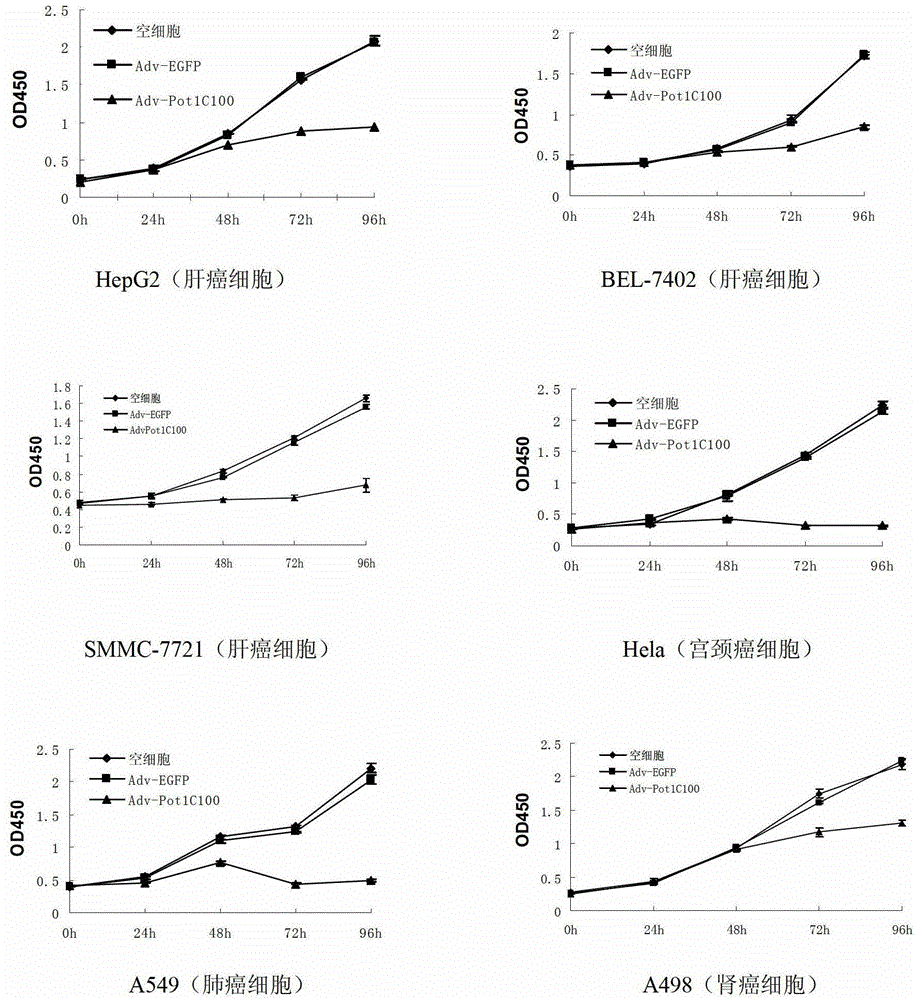Telomeric protein polypeptide fragment with tumor cell killing activity and application thereof
A tumor cell and protein technology, applied in the field of telomere protein polypeptide fragments, can solve problems such as unclear mechanism of action
- Summary
- Abstract
- Description
- Claims
- Application Information
AI Technical Summary
Problems solved by technology
Method used
Image
Examples
Embodiment 1
[0049] Embodiment 1, the preparation of recombinant adenovirus vector Adv-Pot1C100 / EGFP and Adv-EGFP
[0050] Recombinant adenoviral vectors Adv-Pot1C100 / EGFP and Adv-EGFP are constructed based on the Ad-MAX packaging system and prepared by Wujiahe Company. The specific process is as follows:
[0051] 1. Construction of shuttle plasmids for packaging recombinant adenoviruses
[0052] For the convenience of research and to achieve visual markers, the gene encoding the EGFP protein was introduced into the shuttle plasmid, as follows: the gene encoding the EGFP protein (sequence 3 in the sequence listing) was used as a template, and the primers EGFP-up and EGFP-down were used to carry out PCR amplification to obtain a DNA fragment containing restriction endonuclease recognition sites EcoR I and Bgl II at both ends, after double digestion with EcoR I and Bgl II, and the pDC316 vector (this element positive Yang Company, PD-01-28) large fragments were connected, and the obtained r...
Embodiment 2
[0073] Example 2, Effects of Adv-Pot1C100 Infecting Tumor Cells on Cell Growth and Apoptosis
[0074] In this example, the recombinant adenovirus vector Adv-Pot1C100 / EGFP prepared in Example 1 was used to infect telomerase-positive tumor cell lines (HeLa, HepG2, SMMC7721, BEL-7402, A549 and A498) and telomerase-negative tumor cell lines respectively. Tumor cell lines (U2os) and normal human diploid cell lines (WI-38, 2BS and BJ), the effects of Adv-Pot1C100 / EGFP infection on tumor cell growth and apoptosis were detected. The experiment was divided into three groups, one was the blank control group not infected with adenovirus Adv-Pot1C100 / EGFP; the other was the virus control group infected with Adv-EGFP; the third was the experimental group infected with Adv-Pot1C100 / EGFP. Experiments were repeated three times. The specific operation is as follows:
[0075] 1. Growth curve measurement:
[0076] (1) Digest cells with trypsin, neutralize with DMEM medium containing 10% serum...
Embodiment 3
[0087] Example 3, Detection of anti-tumor effect of recombinant adenovirus vector Adv-Pot1C100 / EGFP
[0088] In this example, telomerase-positive tumor cell lines (HeLa, HepG2, SMMC7721 and BEL-7402) were first used to construct a mouse tumor model; then the recombinant adenovirus vector Adv-Pot1C100 / EGFP or Adv-EGFP, observe the change of tumor size, so as to detect the anti-tumor effect of Adv-Pot1C100 / EGFP. The specific operation is as follows:
[0089] 1. Tumor formation experiment in nude mice
[0090] will be 5×10 6 -1×10 7 Two tumor cells (HeLa, HepG2, SMMC7721 or BEL-7402) were subcutaneously injected into the axillae of both sides of female SPF grade athymic nude mice at the age of 4-6 weeks, and the nude mouse tumor formation model was established. Inject 6 mice per cell
[0091] The results showed that mice in SMMC7721 group formed tumors 10 days after injection of tumor cells; mice in BEL-7402 group formed tumors 7 days after injection of tumor cells; mice in...
PUM
 Login to View More
Login to View More Abstract
Description
Claims
Application Information
 Login to View More
Login to View More - R&D
- Intellectual Property
- Life Sciences
- Materials
- Tech Scout
- Unparalleled Data Quality
- Higher Quality Content
- 60% Fewer Hallucinations
Browse by: Latest US Patents, China's latest patents, Technical Efficacy Thesaurus, Application Domain, Technology Topic, Popular Technical Reports.
© 2025 PatSnap. All rights reserved.Legal|Privacy policy|Modern Slavery Act Transparency Statement|Sitemap|About US| Contact US: help@patsnap.com



